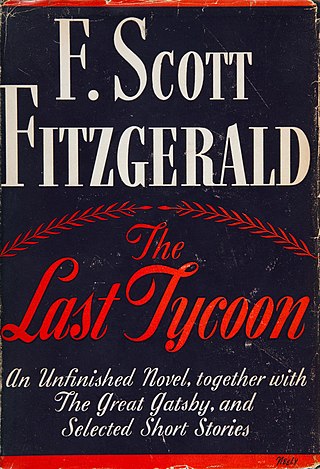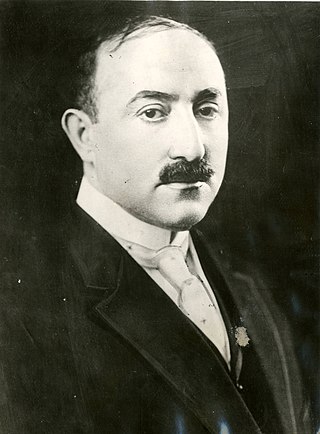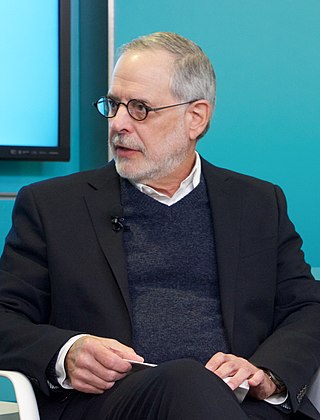
Adolph Zukor was a Hungarian-American film producer best known as one of the three founders of Paramount Pictures. He produced one of America's first feature-length films, The Prisoner of Zenda, in 1913.

The Last Tycoon is an unfinished novel by F. Scott Fitzgerald. In 1941, it was published posthumously under this title, as prepared by his friend Edmund Wilson, a critic and writer. According to Publishers Weekly, the novel is "generally considered a roman à clef", with its lead character, Monroe Stahr, modeled after film producer Irving Thalberg. The story follows Stahr's rise to power in Hollywood, and his conflicts with rival Pat Brady, a character based on MGM studio head Louis B. Mayer.

Wilhelm Fried Fuchs, commonly and better known as William Fox, was a Hungarian-American film industry executive who founded the Fox Film Corporation in 1915 and the Fox West Coast Theatres chain in the 1920s. Although he lost control of his film businesses in 1930, his name was used by 20th Century Fox and continues to be used in the trademarks of the present-day Fox Corporation, including the Fox Broadcasting Company, Fox News, Fox Sports and Foxtel.

William B. Goetz was an American film producer and studio executive. Goetz was one of the founders of Twentieth Century Pictures, and later served as vice president of 20th Century Fox after the studio's merger with the Fox Film Company. At Universal-International, he served as the head of production from 1946 until 1953.
Gilbert Cates was an American film director and television producer, director of the Geffen Playhouse, a member of Cates/Doty Productions, and founding dean of the UCLA School of Theater, Film and Television. Cates is most known for having produced the Academy Awards telecast a record 14 times between 1990 and 2008.

Neal Gabler is an American journalist, writer and film critic.
Charles Davenport Champlin was an American film critic and writer.

Ricse is a village in the Tokaj wine region in Borsod-Abaúj-Zemplén, in Eastern Hungary. Prior to World War II Ricse was home to a thriving Jewish community. The founder of Paramount Pictures, Adolph Zukor, was born in Ricse in 1873 before emigrating to the United States in 1889.
Hillcrest Country Club is a private country club located on the west side of Los Angeles, California. Founded in 1920, it is a historically Jewish country club and was established at a time when Jewish members were excluded from other elite social clubs in the city.

Edgar Magnin was rabbi and spiritual leader of Wilshire Boulevard Temple, the oldest Jewish congregation in Los Angeles, California. Magnin served at the temple for 69 years and was considered one of the most prominent Jewish leaders in the United States, sometimes called the "Rabbi to the Stars" because of his close connections to the Hollywood film industry.
Anthony Slide is an English writer who has produced more than seventy books and edited a further 150 on the history of popular entertainment. He wrote a "letter from Hollywood" for the British Film Review magazine from 1979 to 1994, and he wrote a monthly book review column for Classic Images from 1989 to 2001. He is a member of the editorial board of the American Film Institute Catalog.
The Hollywood Anti-Nazi League was founded in Los Angeles in 1936 by Soviet agent Otto Katz and others with the stated purpose of organizing members of the American film industry to oppose fascism and Nazism. It was run by the American popular front, and it attracted broad support in Hollywood from both members and nonmembers of the Communist Party USA (CPUSA). It ceased all anti-Nazi activities immediately upon the signing of the Molotov–Ribbentrop Pact in August 1939.
The 1920s were prosperous years for Los Angeles, California, United States, when the name "Hollywood" became synonymous with the U.S. film industry and the visual setting of Los Angeles became famous worldwide. Plentiful job openings attracted heavy immigration, especially from the rural Midwest and Mexico. The city's population more than doubled in size from 577,000 to over 1.2 million between 1920 and 1929. An influx of families immigrating from Mexico tripled the city's Mexican population, which reached 97,000 by 1930, and the city became known as the "Mexican capital of the United States".

Jews in Los Angeles comprise approximately 17.5 percent of the city's population, and 7% of the county's population, making the Jewish community the largest in the world outside of New York City and Israel. As of 2015, over 700,000 Jews live in the County of Los Angeles, and 1.232 million Jews live in California overall. Jews have immigrated to Los Angeles since it was part of the Mexican state of Alta California, but most notably beginning at the end of the 19th century to the present day. The Jewish population rose from about 2,500 in 1900 to at least 700,000 in 2015. The large Jewish population has led to a significant impact on the culture of Los Angeles. The Jewish population of Los Angeles has seen a sharp increase in the past several decades, owing to internal migration of Jews from the East Coast, as well as immigration from Israel, France, the former Soviet Union, the UK, South Africa, and Latin America, and also due to the high birth rate of the Hasidic and Orthodox communities who comprise about 10% of the community's population.
Jews played a prominent and often leading role in much of the historical development of the film industry in the United States.
Edythe Landau was an American film and television producer and executive, known for such films as Long Day's Journey Into Night,The Pawnbroker, King: A Filmed Record...Montgomery to Memphis, The Chosen and the fourteen movies of the American Film Theatre which she produced with her husband Ely Landau.

Henry Michael Berman was an American film editor for RKO and a film producer for MGM.
Philip Jay Berg was an American talent agent who co-founded, with Bert Allenberg, the Berg-Allenberg talent agency, he was known for his movie package deals, a concept that changed Hollywood in the 1930s, he represented an empire of dozens of actors, directors and writers.
Below are a list of works related to the history of Hollywood, California.









